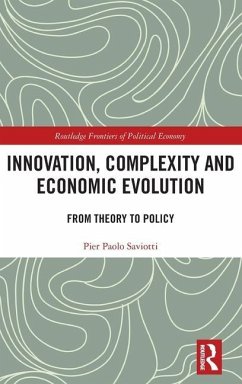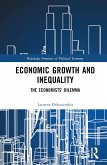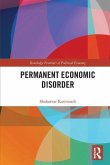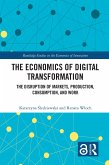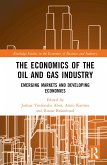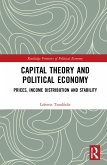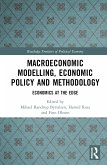- Gebundenes Buch
- Merkliste
- Auf die Merkliste
- Bewerten Bewerten
- Teilen
- Produkt teilen
- Produkterinnerung
- Produkterinnerung
This book argues that evolutionary economics must become evolutionary political economy. The book explores the policy implications of these innovative societies, where wealth is created but unequally distributed. The book is addressed to open-minded economists, social scientists, technologists and policy makers.
Andere Kunden interessierten sich auch für
![Economic Growth and Inequality Economic Growth and Inequality]() Laurent DobuzinskisEconomic Growth and Inequality175,99 €
Laurent DobuzinskisEconomic Growth and Inequality175,99 €![Permanent Economic Disorder Permanent Economic Disorder]() Shahzavar KarimzadiPermanent Economic Disorder39,99 €
Shahzavar KarimzadiPermanent Economic Disorder39,99 €![The Economics of Digital Transformation The Economics of Digital Transformation]() Katarzyna SledziewskaThe Economics of Digital Transformation45,99 €
Katarzyna SledziewskaThe Economics of Digital Transformation45,99 €![The Economics of the Oil and Gas Industry The Economics of the Oil and Gas Industry]() The Economics of the Oil and Gas Industry161,99 €
The Economics of the Oil and Gas Industry161,99 €![Capital Theory and Political Economy Capital Theory and Political Economy]() Lefteris Tsoulfidis (Greece University of Macedonia)Capital Theory and Political Economy56,99 €
Lefteris Tsoulfidis (Greece University of Macedonia)Capital Theory and Political Economy56,99 €![Crime Economics Crime Economics]() Clotilde ChampeyracheCrime Economics55,99 €
Clotilde ChampeyracheCrime Economics55,99 €![Macroeconomic Modelling, Economic Policy and Methodology Macroeconomic Modelling, Economic Policy and Methodology]() Macroeconomic Modelling, Economic Policy and Methodology153,99 €
Macroeconomic Modelling, Economic Policy and Methodology153,99 €-
-
-
This book argues that evolutionary economics must become evolutionary political economy. The book explores the policy implications of these innovative societies, where wealth is created but unequally distributed. The book is addressed to open-minded economists, social scientists, technologists and policy makers.
Produktdetails
- Produktdetails
- Routledge Frontiers of Political Economy
- Verlag: Taylor & Francis Ltd
- Seitenzahl: 268
- Erscheinungstermin: 23. März 2023
- Englisch
- Abmessung: 234mm x 156mm x 18mm
- Gewicht: 556g
- ISBN-13: 9781032278148
- ISBN-10: 1032278145
- Artikelnr.: 66266787
- Herstellerkennzeichnung
- Libri GmbH
- Europaallee 1
- 36244 Bad Hersfeld
- gpsr@libri.de
- Routledge Frontiers of Political Economy
- Verlag: Taylor & Francis Ltd
- Seitenzahl: 268
- Erscheinungstermin: 23. März 2023
- Englisch
- Abmessung: 234mm x 156mm x 18mm
- Gewicht: 556g
- ISBN-13: 9781032278148
- ISBN-10: 1032278145
- Artikelnr.: 66266787
- Herstellerkennzeichnung
- Libri GmbH
- Europaallee 1
- 36244 Bad Hersfeld
- gpsr@libri.de
Pier Paolo Saviotti has been Research Professor in the Grenoble unit of INRA (now INRAE), the National Institute of Agricultural Research of France, and in GREDEG CNRS in Sophia Antipolis. He taught in the Departments of Science and Technology Policy and of Economics of Manchester University (1980-1994) and in Universidad del Zulia, Venezuela. He has been Visiting Professor in the University of Jena (2002-2003), in Rand Afrikaans University (now University of Johannesburg) in 2004, in the University of Hohenheim in 2010-2011, in the Technological University of Eindhoven in 2012-2013 Utrecht university (2015-2017). In 2012 he was research fellow in the Institute of Advanced Studies of Durham University. Between January 2015 and December 2017, he has been visiting Professor in Innovation Studies, Copernicus Institute, Utrecht University. He is now Affiliate Professor, Economics Department, St Anna School of Advanced Studies, Pisa, and associate researcher in GREDEG CNRS, Sophia Antipolis. Between July 2008 and July 2012, he has been vice-president of the International Schumpeter Society. Saviotti is author of several publications about the economics of innovation, of development and the economics of knowledge.
Innovation, Complexity and Economic Evolution: from Theory to Policy *
Pier Paolo Saviotti *
Ch. 1. Manmade artefacts, physical technologies and institutions *
Introduction *
2) Manmade artefacts and structural change in socioeconomic systems *
2.1) MMAs and the twin characteristics representation *
2.2) Generalised production of services. *
2.3) MMAs, wants, needs and basic human functions *
2.4) Analytical implications of the twin characteristic representation *
Fig 1.4. Characteristics representation of pure substitution. T1 =
pre-existing technology; T2 = new technology *
Fig 1.5. Twin characteristics representation of partial substitution. T1 =
old technology, T2 = new technology *
Box 1.1 *
Examples of different types of substitution *
Box 1.2 *
Examples of technological specialization *
3) Concepts in the economics of innovation. *
3.1) Innovation concepts and the twin characteristics representation *
3.2) General Purpose Technologies (GPTs). *
4) MMAs, physical technologies and the environment *
4.1) Sharing economy *
5) Institutions and organizational forms *
5.1) Transformations and transitions *
6) Summary and conclusions *
ECONOMICS, QUALITATIVE CHANGE AND DISCONTINUITIES *
1) The nature of qualitative change *
2) Qualitative and quantitative change *
2.1) Is it possible to distinguish qualitative and quantitative change? *
2.2) Variety vs differentiation *
2.3) Implications of qualitative and quantitative change *
3) Some analytical implications *
3.1) Competition *
3.2) Complementarity *
3.3 Demand theory *
4) Conclusions *
Ch 3 *
ADAPTIVE BEHAVIOUR AS THE MOST GENERAL FORM OF SOCIOECONOMIC BEHAVIOUR *
Introduction *
2) Adaptation and systems *
2.1) System stability and change *
2.2) System dynamics *
2.4) Closed and open systems *
3) Adaptive Behaviour *
3.1) ADTO and ADOF *
3.2) Collective and individual adaptation *
3.3) Adaptation, stability and change *
3.4) Fitness *
3.5) Barriers to adaptation *
4) Adaptive behaviour vs optimizing rationality *
Summary. *
Ch 4. KNOWLEDGE AND ECONOMICS *
1. INTRODUCTION *
2) Some considerations on the nature of knowledge *
2.2) Two properties of knowledge *
2.2.1) Knowledge as a co-relational structure. *
3. Knowledge in socioeconomic systems *
3.1. The production of knowledge *
3.2. Knowledge and institutions *
4). EMPIRICAL APPLICATIONS *
4.1) The knowledge base of the firm *
4.2) Knowledge properties *
5. Summary and conclusions *
Ch 5 Structural change, Differentiation and Economic Development *
1) From stylized facts to theoretical understanding *
1.1) Stylized facts *
1.2) Efficiency and creativity *
1.3) Structural change, differentiation and economic development *
1.5) Structure, order and change *
2) Structural change and differentiation in the literature on economic
growth and development *
2.1) Models *
2.2) Empirical studies of variety and diversification *
3) Present state and future developments *
4) Summary and conclusions *
CH 6. COMPLEXITY AND EVOLUTIONARY THEORIES. *
2) Antecedents and recent developments *
2.1) Evolutionary and constructivist rationalisms as alternative modes of
knowledge. *
2. 2). Structure, order and change *
2.1.3) Rules and institutions *
2.3) Complexity and evolutionary theories *
3) Summary *
Ch 7. EVOLUTIONARY POLITICAL ECONOMICS *
Introduction *
2) On the interactions between innovations, technologies and institutions
in recent history *
2.1) The rise of manufacturing *
2.2) From manufacturing to services *
2.3) Recent trends: globalization, neoliberalism, AI, Knowledge based
economy and society *
3) Human decision-making *
4) Summary and conclusions *
Ch 8 *
POLICY IMPLICATIONS OF EVOLUTIONARY ECONOMICS *
1) Future trends and policy implications *
1.1. World challenges *
1.2) Main points of evolutionary economics *
2) Policy implications *
2.4) Environment *
3) Summary and conclusions of Ch 8 *
REFERENCES *
Pier Paolo Saviotti *
Ch. 1. Manmade artefacts, physical technologies and institutions *
Introduction *
2) Manmade artefacts and structural change in socioeconomic systems *
2.1) MMAs and the twin characteristics representation *
2.2) Generalised production of services. *
2.3) MMAs, wants, needs and basic human functions *
2.4) Analytical implications of the twin characteristic representation *
Fig 1.4. Characteristics representation of pure substitution. T1 =
pre-existing technology; T2 = new technology *
Fig 1.5. Twin characteristics representation of partial substitution. T1 =
old technology, T2 = new technology *
Box 1.1 *
Examples of different types of substitution *
Box 1.2 *
Examples of technological specialization *
3) Concepts in the economics of innovation. *
3.1) Innovation concepts and the twin characteristics representation *
3.2) General Purpose Technologies (GPTs). *
4) MMAs, physical technologies and the environment *
4.1) Sharing economy *
5) Institutions and organizational forms *
5.1) Transformations and transitions *
6) Summary and conclusions *
ECONOMICS, QUALITATIVE CHANGE AND DISCONTINUITIES *
1) The nature of qualitative change *
2) Qualitative and quantitative change *
2.1) Is it possible to distinguish qualitative and quantitative change? *
2.2) Variety vs differentiation *
2.3) Implications of qualitative and quantitative change *
3) Some analytical implications *
3.1) Competition *
3.2) Complementarity *
3.3 Demand theory *
4) Conclusions *
Ch 3 *
ADAPTIVE BEHAVIOUR AS THE MOST GENERAL FORM OF SOCIOECONOMIC BEHAVIOUR *
Introduction *
2) Adaptation and systems *
2.1) System stability and change *
2.2) System dynamics *
2.4) Closed and open systems *
3) Adaptive Behaviour *
3.1) ADTO and ADOF *
3.2) Collective and individual adaptation *
3.3) Adaptation, stability and change *
3.4) Fitness *
3.5) Barriers to adaptation *
4) Adaptive behaviour vs optimizing rationality *
Summary. *
Ch 4. KNOWLEDGE AND ECONOMICS *
1. INTRODUCTION *
2) Some considerations on the nature of knowledge *
2.2) Two properties of knowledge *
2.2.1) Knowledge as a co-relational structure. *
3. Knowledge in socioeconomic systems *
3.1. The production of knowledge *
3.2. Knowledge and institutions *
4). EMPIRICAL APPLICATIONS *
4.1) The knowledge base of the firm *
4.2) Knowledge properties *
5. Summary and conclusions *
Ch 5 Structural change, Differentiation and Economic Development *
1) From stylized facts to theoretical understanding *
1.1) Stylized facts *
1.2) Efficiency and creativity *
1.3) Structural change, differentiation and economic development *
1.5) Structure, order and change *
2) Structural change and differentiation in the literature on economic
growth and development *
2.1) Models *
2.2) Empirical studies of variety and diversification *
3) Present state and future developments *
4) Summary and conclusions *
CH 6. COMPLEXITY AND EVOLUTIONARY THEORIES. *
2) Antecedents and recent developments *
2.1) Evolutionary and constructivist rationalisms as alternative modes of
knowledge. *
2. 2). Structure, order and change *
2.1.3) Rules and institutions *
2.3) Complexity and evolutionary theories *
3) Summary *
Ch 7. EVOLUTIONARY POLITICAL ECONOMICS *
Introduction *
2) On the interactions between innovations, technologies and institutions
in recent history *
2.1) The rise of manufacturing *
2.2) From manufacturing to services *
2.3) Recent trends: globalization, neoliberalism, AI, Knowledge based
economy and society *
3) Human decision-making *
4) Summary and conclusions *
Ch 8 *
POLICY IMPLICATIONS OF EVOLUTIONARY ECONOMICS *
1) Future trends and policy implications *
1.1. World challenges *
1.2) Main points of evolutionary economics *
2) Policy implications *
2.4) Environment *
3) Summary and conclusions of Ch 8 *
REFERENCES *
Innovation, Complexity and Economic Evolution: from Theory to Policy *
Pier Paolo Saviotti *
Ch. 1. Manmade artefacts, physical technologies and institutions *
Introduction *
2) Manmade artefacts and structural change in socioeconomic systems *
2.1) MMAs and the twin characteristics representation *
2.2) Generalised production of services. *
2.3) MMAs, wants, needs and basic human functions *
2.4) Analytical implications of the twin characteristic representation *
Fig 1.4. Characteristics representation of pure substitution. T1 =
pre-existing technology; T2 = new technology *
Fig 1.5. Twin characteristics representation of partial substitution. T1 =
old technology, T2 = new technology *
Box 1.1 *
Examples of different types of substitution *
Box 1.2 *
Examples of technological specialization *
3) Concepts in the economics of innovation. *
3.1) Innovation concepts and the twin characteristics representation *
3.2) General Purpose Technologies (GPTs). *
4) MMAs, physical technologies and the environment *
4.1) Sharing economy *
5) Institutions and organizational forms *
5.1) Transformations and transitions *
6) Summary and conclusions *
ECONOMICS, QUALITATIVE CHANGE AND DISCONTINUITIES *
1) The nature of qualitative change *
2) Qualitative and quantitative change *
2.1) Is it possible to distinguish qualitative and quantitative change? *
2.2) Variety vs differentiation *
2.3) Implications of qualitative and quantitative change *
3) Some analytical implications *
3.1) Competition *
3.2) Complementarity *
3.3 Demand theory *
4) Conclusions *
Ch 3 *
ADAPTIVE BEHAVIOUR AS THE MOST GENERAL FORM OF SOCIOECONOMIC BEHAVIOUR *
Introduction *
2) Adaptation and systems *
2.1) System stability and change *
2.2) System dynamics *
2.4) Closed and open systems *
3) Adaptive Behaviour *
3.1) ADTO and ADOF *
3.2) Collective and individual adaptation *
3.3) Adaptation, stability and change *
3.4) Fitness *
3.5) Barriers to adaptation *
4) Adaptive behaviour vs optimizing rationality *
Summary. *
Ch 4. KNOWLEDGE AND ECONOMICS *
1. INTRODUCTION *
2) Some considerations on the nature of knowledge *
2.2) Two properties of knowledge *
2.2.1) Knowledge as a co-relational structure. *
3. Knowledge in socioeconomic systems *
3.1. The production of knowledge *
3.2. Knowledge and institutions *
4). EMPIRICAL APPLICATIONS *
4.1) The knowledge base of the firm *
4.2) Knowledge properties *
5. Summary and conclusions *
Ch 5 Structural change, Differentiation and Economic Development *
1) From stylized facts to theoretical understanding *
1.1) Stylized facts *
1.2) Efficiency and creativity *
1.3) Structural change, differentiation and economic development *
1.5) Structure, order and change *
2) Structural change and differentiation in the literature on economic
growth and development *
2.1) Models *
2.2) Empirical studies of variety and diversification *
3) Present state and future developments *
4) Summary and conclusions *
CH 6. COMPLEXITY AND EVOLUTIONARY THEORIES. *
2) Antecedents and recent developments *
2.1) Evolutionary and constructivist rationalisms as alternative modes of
knowledge. *
2. 2). Structure, order and change *
2.1.3) Rules and institutions *
2.3) Complexity and evolutionary theories *
3) Summary *
Ch 7. EVOLUTIONARY POLITICAL ECONOMICS *
Introduction *
2) On the interactions between innovations, technologies and institutions
in recent history *
2.1) The rise of manufacturing *
2.2) From manufacturing to services *
2.3) Recent trends: globalization, neoliberalism, AI, Knowledge based
economy and society *
3) Human decision-making *
4) Summary and conclusions *
Ch 8 *
POLICY IMPLICATIONS OF EVOLUTIONARY ECONOMICS *
1) Future trends and policy implications *
1.1. World challenges *
1.2) Main points of evolutionary economics *
2) Policy implications *
2.4) Environment *
3) Summary and conclusions of Ch 8 *
REFERENCES *
Pier Paolo Saviotti *
Ch. 1. Manmade artefacts, physical technologies and institutions *
Introduction *
2) Manmade artefacts and structural change in socioeconomic systems *
2.1) MMAs and the twin characteristics representation *
2.2) Generalised production of services. *
2.3) MMAs, wants, needs and basic human functions *
2.4) Analytical implications of the twin characteristic representation *
Fig 1.4. Characteristics representation of pure substitution. T1 =
pre-existing technology; T2 = new technology *
Fig 1.5. Twin characteristics representation of partial substitution. T1 =
old technology, T2 = new technology *
Box 1.1 *
Examples of different types of substitution *
Box 1.2 *
Examples of technological specialization *
3) Concepts in the economics of innovation. *
3.1) Innovation concepts and the twin characteristics representation *
3.2) General Purpose Technologies (GPTs). *
4) MMAs, physical technologies and the environment *
4.1) Sharing economy *
5) Institutions and organizational forms *
5.1) Transformations and transitions *
6) Summary and conclusions *
ECONOMICS, QUALITATIVE CHANGE AND DISCONTINUITIES *
1) The nature of qualitative change *
2) Qualitative and quantitative change *
2.1) Is it possible to distinguish qualitative and quantitative change? *
2.2) Variety vs differentiation *
2.3) Implications of qualitative and quantitative change *
3) Some analytical implications *
3.1) Competition *
3.2) Complementarity *
3.3 Demand theory *
4) Conclusions *
Ch 3 *
ADAPTIVE BEHAVIOUR AS THE MOST GENERAL FORM OF SOCIOECONOMIC BEHAVIOUR *
Introduction *
2) Adaptation and systems *
2.1) System stability and change *
2.2) System dynamics *
2.4) Closed and open systems *
3) Adaptive Behaviour *
3.1) ADTO and ADOF *
3.2) Collective and individual adaptation *
3.3) Adaptation, stability and change *
3.4) Fitness *
3.5) Barriers to adaptation *
4) Adaptive behaviour vs optimizing rationality *
Summary. *
Ch 4. KNOWLEDGE AND ECONOMICS *
1. INTRODUCTION *
2) Some considerations on the nature of knowledge *
2.2) Two properties of knowledge *
2.2.1) Knowledge as a co-relational structure. *
3. Knowledge in socioeconomic systems *
3.1. The production of knowledge *
3.2. Knowledge and institutions *
4). EMPIRICAL APPLICATIONS *
4.1) The knowledge base of the firm *
4.2) Knowledge properties *
5. Summary and conclusions *
Ch 5 Structural change, Differentiation and Economic Development *
1) From stylized facts to theoretical understanding *
1.1) Stylized facts *
1.2) Efficiency and creativity *
1.3) Structural change, differentiation and economic development *
1.5) Structure, order and change *
2) Structural change and differentiation in the literature on economic
growth and development *
2.1) Models *
2.2) Empirical studies of variety and diversification *
3) Present state and future developments *
4) Summary and conclusions *
CH 6. COMPLEXITY AND EVOLUTIONARY THEORIES. *
2) Antecedents and recent developments *
2.1) Evolutionary and constructivist rationalisms as alternative modes of
knowledge. *
2. 2). Structure, order and change *
2.1.3) Rules and institutions *
2.3) Complexity and evolutionary theories *
3) Summary *
Ch 7. EVOLUTIONARY POLITICAL ECONOMICS *
Introduction *
2) On the interactions between innovations, technologies and institutions
in recent history *
2.1) The rise of manufacturing *
2.2) From manufacturing to services *
2.3) Recent trends: globalization, neoliberalism, AI, Knowledge based
economy and society *
3) Human decision-making *
4) Summary and conclusions *
Ch 8 *
POLICY IMPLICATIONS OF EVOLUTIONARY ECONOMICS *
1) Future trends and policy implications *
1.1. World challenges *
1.2) Main points of evolutionary economics *
2) Policy implications *
2.4) Environment *
3) Summary and conclusions of Ch 8 *
REFERENCES *

